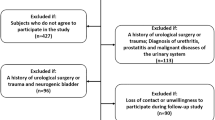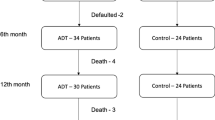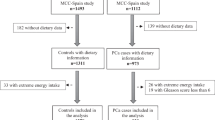Abstract
We retrospectively studied anthropometric and laboratory parameters (including serum triglycerides, cholesterol), as well as comedication in 504 patients diagnosed with prostate cancer between January 1997 and August 2002 at a single referral center, and compared these patients with 565 age-matched patients with benign prostatic hyperplasia. A positive correlation was found between serum triglycerides and prostate cancer (odds ratio: 1.148/mmol/l; 95% confidence interval (CI) 1.003–1.315; P<0.05) after correcting for age, body mass index, diabetes and comedication with statins. Hypertriglyceridemia may increase the risk of prostate cancer, and the prognostic relevancy of serum triglycerides should be studied prospectively.
This is a preview of subscription content, access via your institution
Access options
Subscribe to this journal
Receive 4 print issues and online access
$259.00 per year
only $64.75 per issue
Buy this article
- Purchase on Springer Link
- Instant access to full article PDF
Prices may be subject to local taxes which are calculated during checkout


Similar content being viewed by others
References
Jemal A et al. Cancer statistics. CA Cancer J Clin 2003; 53: 5–26.
Meigs JB et al. Risk factors for clinical benign prostatic hyperplasia in a community-based population of healthy aging men. J Clin Epidemiol 2001; 54: 935–944.
Rao AV, Fleshner N, Agarwal S . Serum and tissue lycopene and biomarkers of oxidation in prostate cancer patients: a case–control study. Nutr Cancer 1999; 33: 159–164.
Li H et al. Manganese superoxide dismutase polymorphism, prediagnostic antioxidant status, and risk of clinical significant prostate cancer. Cancer Res 2005; 65: 2498–2504.
Eaton NE, Reeves GK, Appleby PN, Key TJ . Endogenous sex hormones and prostate cancer: a quantitative review of prospective studies. Br J Cancer 1999; 80: 930–934.
Kolonel LN . Nutrition and prostate cancer. Cancer Causes Control 1996; 7: 83–94.
Armstrong B, Doll R . Environmental factors and cancer incidence and mortality in different countries, with special reference to dietary practices. Int J Cancer 1975; 15: 617–631.
Giovannucci E et al. A prospective study of dietary fat and risk of prostate cancer. J Natl Cancer Inst 1993; 85: 1571–1579.
Heshmat MY et al. Nutrition and prostate cancer: a case–control study. Prostate 1985; 6: 7–17.
Veierod MB, Laake P, Thelle DS . Dietary fat intake and risk of prostate cancer: a prospective study of 25 708 Norwegian men. Int J Cancer 1997; 73: 634–638.
Gann PH et al. Prospective study of plasma fatty acids and risk of prostate cancer. J Natl Cancer Inst 1994; 86: 281–286.
Harvei S et al. Prediagnostic level of fatty acids in serum phospholipids: omega-3 and omega-6 fatty acids and the risk of prostate cancer. Int J Cancer 1997; 71: 545–551.
Kolonel LN, Yoshizawa CN, Hankin JH . Diet and prostatic cancer: a case-control study in Hawaii. Am J Epidemiol 1988; 127: 999–1012.
West DW et al. Adult dietary intake and prostate cancer risk in Utah: a case-control study with special emphasis on aggressive tumors. Cancer Causes Control 1991; 2: 85–94.
Andersson SO et al. Energy, nutrient intake and prostate cancer risk: a population-based case-control study in Sweden. Int J Cancer 1996; 68: 716–722.
Samanic C et al. Obesity and cancer risk among white and black United States veterans. Cancer Causes Control 2004; 15: 35–43.
Engeland A, Tretli S, Bjorge T . Height, body mass index, and prostate cancer: a follow-up of 950 000 Norwegian men. Br J Cancer 2003; 89: 1237–1242.
International Agency for Research on Cancer. IARC Handbooks of Cancer Prevention. Weight Control and Physical Activity. International Agency for Research on Cancer: Lyon, 2002.
Pan SY et al. Association of obesity and cancer risk in Canada. Am J Epidemiol 2004; 159: 259–268.
Calle EE, Kaaks R . Overweight, obesity and cancer: epidemiological evidence and proposed mechanisms. Nat Rev Cancer 2004; 4: 579–591.
Calle EE, Rodriguez C, Walker-Thurmond K, Thun MJ . Overweight, obesity, and mortality from cancer in a prospectively studied cohort of U.S. adults. N Engl J Med 2003; 348: 1625–1638.
Suzuki S et al. Intakes of energy and macronutrients and the risk of benign prostatic hyperplasia. Am J Clin Nutr 2002; 75: 689–697.
Zamboni PF et al. Metabolic profile in patients with benign prostate hyperplasia or prostate cancer and normal glucose tolerance. Horm Metab Res 2003; 35: 296–300.
Mochtar CA et al. Prostate-specific antigen as an estimator of prostate volume in the management of patients with symptomatic benign prostatic hyperplasia. Eur Urol 2003; 44: 695–700.
Michaud DS et al. A prospective study on intake of animal products and risk of prostate cancer. Cancer Causes Control 2001; 12: 557–567.
Pollard M, Luckert PH . Promotional effects of testosterone and dietary fat on prostate carcinogenesis in genetically susceptible rats. Prostate 1985; 6: 1–5.
Attar-Bashi NM, Frauman AG, Sinclair AJ . Alpha-linolenic acid and the risk of prostate cancer. What is the evidence? J Urol 2004; 171: 1402–1407.
Alberg AJ et al. Fatty acid levels and the subsequent development of prostate cancer. Proc Am Assoc Cancer Res 37; 281: 1996.
Schaffner CP . Prostatic cholesterol metabolism: regulation and alteration. In: Alan R, (ed) The Prostatic Cell: Structure and Function. Liss Inc.: New York, NY, 1981; pp 279–324.
Acknowledgements
M Joerger is supported by a fellowship grant funded by the European Society of Medical Oncology and by a research grant from the Swiss National Science Foundation (PBBSB-102331).
Author information
Authors and Affiliations
Corresponding author
Rights and permissions
About this article
Cite this article
Wuermli, L., Joerger, M., Henz, S. et al. Hypertriglyceridemia as a possible risk factor for prostate cancer. Prostate Cancer Prostatic Dis 8, 316–320 (2005). https://doi.org/10.1038/sj.pcan.4500834
Received:
Revised:
Accepted:
Published:
Issue Date:
DOI: https://doi.org/10.1038/sj.pcan.4500834
Keywords
This article is cited by
-
Establishment and validation of serum lipid-based nomogram for predicting the risk of prostate cancer
BMC Urology (2023)
-
Histone H2A Lys130 acetylation epigenetically regulates androgen production in prostate cancer
Nature Communications (2023)
-
Sex/gender differences in metabolic syndrome among cancer survivors in the US: an NHANES analysis
Journal of Cancer Survivorship (2023)
-
Elevated serum triglyceride levels may be a key independent predicting factor for gallbladder cancer risk in gallbladder stone disease patients: a case–control study
BMC Endocrine Disorders (2022)
-
Association of serum lipid levels and prostate cancer severity among Hispanic Puerto Rican men
Lipids in Health and Disease (2015)



